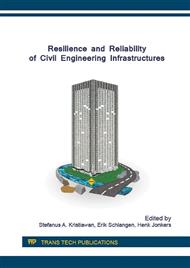p.193
p.202
p.208
p.214
p.220
p.226
p.233
p.240
p.246
Steel Fiber Reinforced Concrete to Improve the Characteristics of Fire-Resistant Concrete
Abstract:
The effect of strength, weight, and fibers on properties of concrete at different temperatures is highlighted at this research to analyze the compressive strength and modulus of elasticity of steel fiber reinforced concrete (SFRC) on 1% and 1.5% of volume fractions at three temperature levels 200°C, 400°C and 600°C. This study compare the compressive strength and modulus elasticity between normal concrete and SFRC in various volume fraction of steel fiber as reinforcement on elevated temperature heating up to 600°C. Materials were tested to find out the quality of the material before making the concrete specimen. The tests were performed compressive test and modulus of elasticity. The addition of 1% and 1.5% steel fiber in concrete mix is advantageous for concrete. Overall the compressive strength of concrete was increased as the percentage of steel fiber in concrete increases. At 1.5%, steel fiber reinforced concrete showed a better overall residual strength and better crack resistance than non-fiber concrete. The carbonation process for concrete with steel fiber is a little influenced by temperature compare to concrete without steel fiber. The concrete with 1.5 % steel fiber demonstrated the highest compressive and modulus of elasticity value, 23.5 and 17172MPa at 600°C respectively. It is expected that in future concrete having steel fiber will act as a fire protective considerably.
Info:
Periodical:
Pages:
220-225
Citation:
Online since:
July 2016
Keywords:
Price:
Сopyright:
© 2016 Trans Tech Publications Ltd. All Rights Reserved
Share:
Citation:


